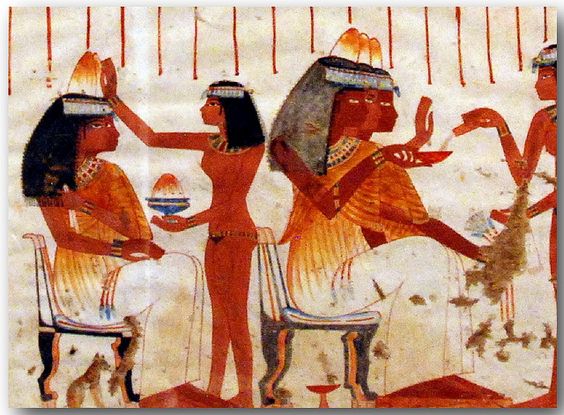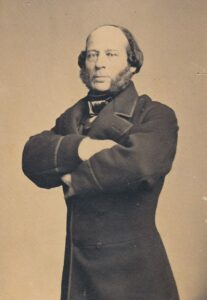The Egyptians, along with the other ancient civilizations, were complex societies. Their culture has many similarities with modern societies, one of which was their concern for beauty. Egyptians went to great lengths to ensure that they were portrayed as flatteringly as possible, rarely depicting their true age. Youth was seen as central to their concept of beauty.

When one looks at human depictions in the artwork of the ancient Egyptians, one may notice the black lines around their eyes. Upon closer attention to detail, one notices that it resembles the way girls today apply eyeliner. This is what was intriguing enough to spark questions about the Egyptian society’s views on cosmetics. Was it a statement of beauty? Of power? Did it relate to their status?
There is evidence to support the generalization that Egyptians may in fact have valued beauty even more than we do today. They expressed their fondness for beauty in their artwork. Their sculptures and paintings provide evidence for how they valued beauty. The value they saw in beauty is depicted in their paintings and sculptures, such as the bust of Nefertiti, which was made to make her look flawless. They also used eye paints (similar to today’s eyeliner), and it was typically made from malachite and galena. Eventually galena became the country’s primary eye paint, and both are found in tombs on pallets and stones that are believed to have been used in preparation of the paints.1
The image to the left is a statue from the Egyptian Museum of Cairo. This statue gives us a visual representation of the ideal form of a male. One may notice the square, wide shoulders, a slim, muscular figure, and a very defined face shape.

The image to the left is a bust of Nefertiti, the great Royal Wife of the Pharaoh Akhenaten. It is believed to be sculpted by Thutmose, who is believed to be the official court sculptor of Pharaoh Akhenaten.2 It was recovered in his workshop and is believed to have been sculpted in 1345 BCE. Nefertiti was a staple for beauty in her time, and her husband strove to make her co-equal with himself, making her one of the most powerful women ever to rule. Nefertiti was universally portrayed as beautiful, and her beauty can still be appreciated today. As one can see in this bust, the queen was sculpted to depict an exemplar of beauty, with a slim face, painted lips, long neck, and adornments on her head and clothes.3
It seems that maybe the Egyptians were more beauty crazed than people of our generation. It is apparent that the ancient Egyptians did not find pride or beauty in older ages. They preferred to alter the way they looked, instead of having themselves accurately represented. It gives us the impression that maybe this ancient culture is not as different from ours as we may have initially assumed.
- A. Lucas, “Cosmetics, Perfumes and Incense in Ancient Egypt,” The Journal of Egyptian Archaeology 16, no. 1/2 (1930): 41. ↵
- Who’s Who in Ancient Egypt, Routledge, 2003. s.v. “Thutmose (c. 1352 – 1366 BC), ” by Michael Rice. ↵
- Thutmose. Bust of Queen Nefertiti, Egyptian Museum Berlin, n.d. http://www.egyptian-museum-berlin.com/c53.php. ↵



65 comments
Maria Esquivel
I find it interesting what beauty meant to the Egyptian’s and how they expressed themselves in paint. Makeup today is used as an expression of art or as a way to feel good about oneself and to read how the ancient culture and our culture see make up and beauty really puts it into perspective how much alike we are than different.
Vanessa Tombo
The title of this article was very intriguing and captivating. From a young age, I quickly noticed how beauty and its standards differ from one country to the next. Having lived in Congo, Kenya, Rwanda and now America. I saw how each country had its own unique beauty trends. This article showed me just how Egypt and America have similar beauty techniques.
Belia Camarena
I find it fascinating that ancient societies have so much in common with modern day societies. The people of ancient Egypt existed thousands of years ago, yet they were concerned with many of the same things that we are today. Like us, they placed a large emphasis on beauty by using cosmetics, and they praised images of youth. It’s cool to see that some societal values transcend time and technology advancement.
Erin Vento
Its funny to see that makeup and beauty standards are not a new concept. Watching the Cleopatra movie, I thought he elaborate and beauty makeup was far fetched, but this article may have changed my mind on that. It’s hard to figure out why we do it, but putting so much emphasis on youth- us and the Egyptian women- it’s easy to understand.
Evelin Joseph
I was aware that Egyptians used makeup, but through this article I was excited to learn that they were greatly concerned with beauty and more “modern” ideas. It is crazy to imagine that such a civilization may have valued beauty and age more that we do in our present situation. The story of Nefertiti was a great addition to this article, and it was definitely new to hear that she was one of the most powerful women in her time as I had never been introduced to her before. Overall, through this article I started to notice similarities between the Egyptian society and our current times that I had never encountered or thought about before.
Crystalrose Quintero
I think it was interesting to see that ancient Egyptians also had forms of cosmetics to better their appearance. Eyeliner before reading this seemed to be something that may have been created during the 1900’s. Also its interesting to think that natural beauty with age wasn’t exactly cherished. Thats something that people are used to seeing in today’s age but not necessarily in the past times.
Benjamin Voy
This is a very interesting article in which I found fascinating. Its strange to see that the Egyptians, who were so far behind in most things, were so far ahead in something like make up and beauty. I don’t know how or why they took such pride in this element of their life but it must have been some sort of power play, in order to show a high status. Just like one would buy an expensive house or car nowadays.
Great read
Alejandra Mendez
This is a very interesting article and I never thought about connecting both times until now that I have read more about their culture and compared it to ours. I can definitely see the similarities with the evidence the article provides. I can also definitely agree with what the article says in that they tried preserving their youth and beauty as much as possible. They viewed youth as beauty and in our times, we see more beauty in youth as well. This was a very well written and thought out article with many things to learn from.
Oceane Roux
Thank you for this great article! I honestly think that beauty is subjective and the way we see beauty might not be the same as the Egyptians did. Indeed, the criteria of beauty change from a country to another, for example, in some cultures, being overweight is a standard of beauty when in others being skinny is “preferred.” However, I find it interesting that they could have used some products such as the eye liner for the same purpose that we do nowadays.
Zeresh Haman
I really enjoyed this article. I have always seen pictures of Hieroglyphics that depict women applying makeup, so I knew that they did. I was unaware of how important youth was to the Egyptians. I think its very interesting to think about how even back then older women were trying to make themselves look younger. I so wonder how young girls started to wear the eye paint, just to see if it is parallel with today how girls are starting to wear makeup younger and younger. It is very interesting to think about how even then women were worried about their appearance.